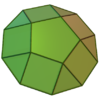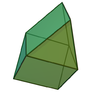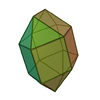Loading AI tools
In geometry, polyhedra are three-dimensional objects where points are connected by lines to form polygons. The points, lines, and polygons of a polyhedron are referred to as its vertices, edges, and faces, respectively.[1] A polyhedron is considered to be convex if:[2]
- The shortest path between any two of its vertices lies either within its interior or on its boundary.
- None of its faces are coplanar—they do not share the same plane and do not "lie flat".
- None of its edges are colinear—they are not segments of the same line.
A convex polyhedron whose faces are regular polygons is known as a Johnson solid, or sometimes as a Johnson–Zalgaller solid. Some authors exclude uniform polyhedra from the definition. A uniform polyhedron is a polyhedron in which the faces are regular and they are isogonal; examples include Platonic and Archimedean solids as well as prisms and antiprisms.[3] The Johnson solids are named after American mathematician Norman Johnson (1930–2017), who published a list of 92 such polyhedra in 1966. His conjecture that the list was complete and no other examples existed was proven by Russian-Israeli mathematician Victor Zalgaller (1920–2020) in 1969.[4]
Some of the Johnson solids may be categorized as elementary polyhedra, meaning they cannot be separated by a plane to create two small convex polyhedra with regular faces. The Johnson solids satisfying this criteria are the first six—equilateral square pyramid, pentagonal pyramid, triangular cupola, square cupola, pentagonal cupola, and pentagonal rotunda. The criteria is also satisfied by eleven other Johnson solids, specifically the tridiminished icosahedron, parabidiminished rhombicosidodecahedron, tridiminished rhombicosidodecahedron, snub disphenoid, snub square antiprism, sphenocorona, sphenomegacorona, hebesphenomegacorona, disphenocingulum, bilunabirotunda, and triangular hebesphenorotunda.[5] The rest of the Johnson solids are not elementary, and they are constructed using the first six Johnson solids together with Platonic and Archimedean solids in various processes. Augmentation involves attaching the Johnson solids onto one or more faces of polyhedra, while elongation or gyroelongation involve joining them onto the bases of a prism or antiprism, respectively. Some others are constructed by diminishment, the removal of one of the first six solids from one or more of a polyhedron's faces.[6]
The following table contains the 92 Johnson solids, with edge length . The table includes the solid's enumeration (denoted as ).[7] It also includes the number of vertices, edges, and faces of each solid, as well as its symmetry group, surface area , and volume . Every polyhedron has its own characteristics, including symmetry and measurement. An object is said to have symmetry if there is a transformation that maps it to itself. All of those transformations may be composed in a group, alongside the group's number of elements, known as the order. In two-dimensional space, these transformations include rotating around the center of a polygon and reflecting an object around the perpendicular bisector of a polygon. A polygon that is rotated symmetrically by is denoted by , a cyclic group of order ; combining this with the reflection symmetry results in the symmetry of dihedral group of order .[8] In three-dimensional symmetry point groups, the transformations preserving a polyhedron's symmetry include the rotation around the line passing through the base center, known as the axis of symmetry, and the reflection relative to perpendicular planes passing through the bisector of a base, which is known as the pyramidal symmetry of order . The transformation that preserves a polyhedron's symmetry by reflecting it across a horizontal plane is known as the prismatic symmetry of order . The antiprismatic symmetry of order preserves the symmetry by rotating its half bottom and reflection across the horizontal plane.[9] The symmetry group of order preserves the symmetry by rotation around the axis of symmetry and reflection on the horizontal plane; the specific case preserving the symmetry by one full rotation is of order 2, often denoted as .[10] The mensuration of polyhedra includes the surface area and volume. An area is a two-dimensional measurement calculated by the product of length and width; for a polyhedron, the surface area is the sum of the areas of all of its faces.[11] A volume is a measurement of a region in three-dimensional space.[12] The volume of a polyhedron may be ascertained in different ways: either through its base and height (like for pyramids and prisms), by slicing it off into pieces and summing their individual volumes, or by finding the root of a polynomial representing the polyhedron.[13]
References
Bibliography
External links
Wikiwand in your browser!
Seamless Wikipedia browsing. On steroids.
Every time you click a link to Wikipedia, Wiktionary or Wikiquote in your browser's search results, it will show the modern Wikiwand interface.
Wikiwand extension is a five stars, simple, with minimum permission required to keep your browsing private, safe and transparent.
















 ...
...



















































































































































































